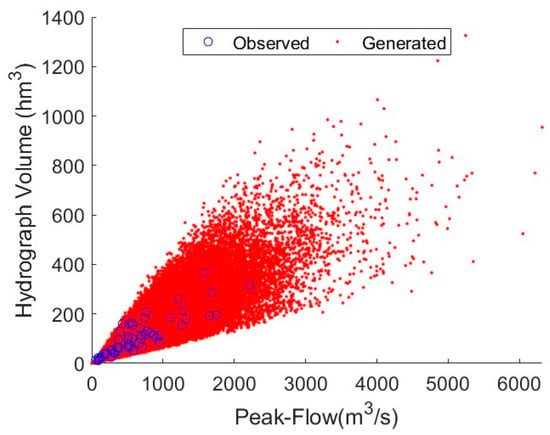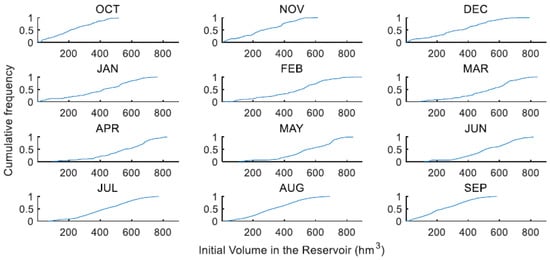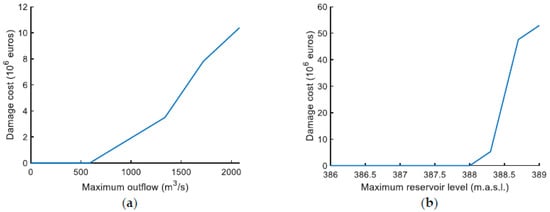Abstract
Hydrological dam safety assessment methods traditionally assume that the reservoir is full while it receives the design flood. In practice, reservoir management strategy determines the probability distribution of reservoir levels at the beginning of flood episodes. In this study, we present a method to economically assess the influence of reservoir management strategy on hydrological dam safety and downstream flood risk. The method was applied to a gated spillway dam located in the Tagus River basin. A set of 100,000 inflow hydrographs was generated through a Monte Carlo procedure, reproducing the observed statistics of main hydrograph characteristics: peak flow, volume, and duration. The set of 100,000 hydrographs was routed through the reservoir applying the volumetric evaluation method as a flood control strategy. Three different scenarios were studied: Initial reservoir level equal to maximum normal level, equal to a maximum conservation level, and following the probability distribution of initial reservoir levels. In order to evaluate economically the influence of initial variable reservoir level and compare the three scenarios, a global risk index was applied. The index combines the hydrological risk for the dam, linked to the maximum water level experienced in the reservoir while the flood is routed, and the flood risk in the downstream river reach, linked to the discharge releases from the dam. The results highlighted the importance of considering the fluctuation of initial reservoir level for assessing the risk related to hydrological dam safety.
Keywords:
hydrological dam safety; downstream safety; volumetric evaluation method; global risk index; initial reservoir level PACS:
J0101
1. Introduction
The failure of large dams is a concern in many countries due to the high economic and social consequences associated with it. When designing a dam, engineers usually use techniques to assure that the risk associated to dam failure is low, being the standards applied different depending on the country in which the dam is located []. Even though the risk is low, the associated risk must be analyzed and updated, as the dam characteristics and climate conditions may vary along time [].
The dam risk assessment field has evolved worldwide, with the appearance of different guides and procedures in several countries [,,] to support dam stakeholders in the decision-making process related to dam safety.
Within this study, we proposed a methodology to analyze economically the influence of initial reservoir level in hydrological dam and downstream safety by the application of economic risk- indexes [,]. To do so, a stochastic procedure is proposed. First, we introduce the proposed methodology. Afterwards, we apply this methodology to a dam configuration based on a real case study. Finally, we analyze and discuss the results obtained, highlighting the main conclusions of this study.
2. Materials and Methods
A probabilistic approach was implemented within a Monte Carlo framework. The process was as follows:
- Generation of synthetic inflow hydrographs. An ensemble of synthetic inflow hydrographs representative of the observed historical annual maximum floods was generated.
- Stochastic initial reservoir level assignation. Depending on the scenario studied (a total of three, as will be explained in Section 2.2), an initial reservoir level was assigned to each inflow hydrograph.
- Reservoir-Dam system routing. The ensemble of hydrographs was routed through the reservoir, obtaining a set of maximum reservoir levels and maximum outflows for each of the three scenarios studied.
- Risk-Index analysis. By using a global risk index analysis [,], we compared all the scenarios economically.
2.1. Generation of Synthetic Reservoir Inflow Hydrographs
In several countries, regulations require to consider return periods up to 10,000 years []. To assure that the results obtained were representative, a set of 100,000 hydrographs was generated [,,] applying a methodology previously presented by Gabriel-Martin et al. []. This methodology permits to obtain stochastic inflow hydrographs representative of the peak flow, volume, and duration of the observed annual floods. The reader is referred to Gabriel-Martin et al. publication [] for further details.
2.2. Initial Reservoir Level. Studied Scenarios
In order to assess the influence of initial reservoir levels, we studied three different scenarios:
- Scenario 1 (Sc.1): For all the 100,000 hydrographs, initial reservoir level was set equal to Maximum Normal Level (MNL).
- Scenario 2 (Sc.2): For all the 100,000 hydrographs, initial reservoir level was set equal to the Flood Control Level (FCL). We defined this level as the level that makes the maximum water reservoir level of return period 1000 years equal to the Design Flood Level (DFL), fulfilling the regulation standards [].
- Scenario 3 (Sc.3): For each one of the 100,000 hydrographs, a variable initial reservoir level was assigned. To do so, we analyzed daily reservoir levels measurements in the reservoir.
2.3. Reservoir-Dam System Routing. Maximum Water Reservoir Level and Maximum Outflow Frequency Curves
For each generated hydrograph (100,000 incoming floods) and scenario, we simulated the operation of the dam gates applying the volumetric evaluation method (VEM) [,]. VEM is a real- time flood control method usually applied in Spanish dams. This method is based on four principles:
- Outflows are lower than or equal to the maximum antecedent inflows.
- Outflows increase when inflows increase.
- The higher the reservoir level, the higher the percentage of outflow increase.
- If the reservoir is at maximum capacity, outflows are equal to inflows while gates are partially opened.
At each time step (hourly), the released outflow was the minimum among: (a) The outflows proposed by VEM, (b) the maximum discharge capacity at the current reservoir level, and (c) the maximum of the antecedent inflows. Once the gates were completely opened, the spillway structure behaves as a fixed crest spillway. The initial reservoir level depended on the scenario studied. After applying the VEM to all scenarios, for each scenario we obtained a set of 100,000 reservoir level and 100,000 outflow flood control time series, from which we derived the maximum water reservoir levels (MWRL) and maximum outflows (MO) frequency curves.
2.4. Risk Index Analysis
To carry on an economic assessment of the obtained result, we implemented the global risk index (IR) analysis proposed by Bianucci et al. []. This method accounts for a single indicator of the global risk associated for the MWRL and MO applying the concept of expected annual damage [] using damage cost curves.
2.5. Limitations of the Methodology
The methodology applied had some limitations that should be noted:
- Regarding to the inflow hydrographs, the limitations of the methodology are those exposed in Reference [].
- Regarding to the flood control operation method (VEM), it has the advantage of its simplicity. However, it is a fixed method that cannot be adapted to the specific conditions of the dam, other than the flood control volume. Other flood control management models could have been tested, for instance, the K-Method [].
- The methodology was applied to one dam with a determined configuration. This could limit the generalization of the results obtained. For instance, results related to initial reservoir level could variate if there are modifications in the regular operation of the reservoir.
2.6. Case Study
The proposed methodology was applied in a case study based on a gated spillway gravity dam located in the Tagus river basin. The dam is located in the province of Caceres, in the west of Spain. The dam basin has an area of 1850 km2. The climate of the region is Continental (mean annual precipitation of 1000 mm and a mean annual runoff value of 1020 hm3). The main purpose of the reservoir is irrigation.
The characteristics of the basin and dam-reservoir system configuration are shown in Table 1. The dam spillway consists of five gates, each one being 10 m wide by 5.75 m high, which compose the main spillway. The other operative discharge structure considered is a bottom outlet in the dam body.

Table 1.
Characteristic reservoir levels and spillway of the dam configuration studied.
To carry on the study, we used a gauge station located at the reservoir location with data of daily flows and reservoir volumes from 1958/59 to 2012/13 (hydrological years, from October 1 to September 30). With these data, we were able to generate the synthetic inflow hydrographs and generate the initial reservoir levels for Sc.3.
3. Results and Discussion
3.1. Generation of Synthetic Reservoir Inflow Hydrographs
We generated 100,000 reservoir inflow hydrographs stochastically using the available 55 years of daily reservoir inflow data (1958/59–2012/13). Figure 1 shows the peak-flow volume relationship between the observed and generated sample, showing how the synthetic events represent correctly the main hydrograph characteristics.

Figure 1.
Synthetic inflow hydrograph generation. Sample of 100,000 simulated floods (red dots) and its comparison to the observed floods (blue-edged circles). Horizontal axis shows values of peak-flow, whereas the vertical axis represents the hydrograph volume.
3.2. Initial Reservoir Level Assessment
In order to assess initial reservoir level, we carried out an analysis of observed data:
- First, we analyzed in which months annual maximum observed flood occurred (1958/59 to 2012/13) and obtained the probability distribution of monthly annual floods.
- Afterwards, we analyzed the daily reservoir volumes in the reservoir to obtain the initial reservoir volume frequency distribution. To do so, we discarded reservoir data from 1958/59 to 1965/1966, as those years did not represent normal operation years as the reservoir was filling up []. Therefore, we obtained the cumulative frequency distribution of exceedance of the monthly daily reservoir levels using the reservoir level time series from 1966/67 to 2012/13 (Figure 2).
 Figure 2. Initial reservoir level assessment. Empirical reservoir level distributions associated to each month of the year.
Figure 2. Initial reservoir level assessment. Empirical reservoir level distributions associated to each month of the year.
3.3. Maximum Water Reservoir Level and Maximum Outflow Frequency Curves
As exposed in the methodology we obtained 100,000 MWRLs and 100,000 MOs for each one of the three scenarios. These frequency curves were necessary to proceed with the global risk index analysis of Section 3.4.
3.4. Risk Index Analysis
We quantified the influence of initial reservoir variability applying the global index procedure []. To do so, we obtained damage cost curves associated to the maximum outflows (Figure 3a) and maximum reservoir levels (Figure 3b). We obtained the global risk index for each one of the three scenarios as shown in Table 2.

Figure 3.
Damage cost curves. (a) Damage cost curves associated with maximum outflows and (b) damage cost curves associated with maximum reservoir levels.

Table 2.
Global risk index for the different scenarios.
4. Conclusions
The proposed methodology permits to asses through a stochastic procedure the influence of initial reservoir level and its influence in economic risk indexes. The results obtained showed:
- For the case study, considering the fluctuation of initial reservoir level provided a more realistic assessment of hydrological dam and downstream safety.
- The global risk index reduced its value up to 93% if variable initial reservoir level is accounted, from 1445.6 × 103 to a value of 93.0 × 103 euros in the case study.
Author Contributions
I.G.-M. proposed the methodology, conducted the numerical experiments, and participated in paper writing; A.S.-W. and L.G. participated in the analysis and discussion of results, contributing to the general idea of the research; and I.G. helped in the general idea of the research and wrote the English edition of the manuscript.
Acknowledgments
The authors would like to thank the funds from Fundación José Entrecanales Ibarra in the framework of the Program “Support program for research purposes”. The authors acknowledge the computer resources and technical assistance provided by the Centro de Supercomputación y Visualización de Madrid (CeSViMa) and the funds from Universidad Politécnica de Madrid in the framework of their Program “Ayudas para contratos predoctorales para la realización del doctorado en sus escuelas, facultad, centro e institutos de I+D+i” and in the framework of their Program “Ayudas a dirigidas a jóvenes investigadores doctores para fortalecer sus planes de investigación” and “Consejo Social: XVI Convocatoria de ayudas del consejo social para el fomento de la formación y la internacionalización de doctorandos”.
Conflicts of Interest
The authors declare no conflict of interest. The founding sponsors had no role in the design of the study; in the collection, analyses, or interpretation of data; in the writing of the manuscript, and in the decision to publish the results.
References
- Ren, M.; He, X.; Kan, G.; Wang, F.; Zhang, H.; Li, H.; Cao, D.; Wang, H.; Sun, D.; Jiang, X.; et al. A Comparison of Flood Control Standards for Reservoir Engineering for Different Countries. Water 2017, 9, 152. [Google Scholar] [CrossRef]
- Fluixá-Sanmartín, J.; Altarejos-García, L.; Morales-Torres, A.; Escuder-Bueno, I. Review article: Climate change impacts on dam safety. Nat. Hazards Earth Syst. Sci. 2018, 18, 2471–2488. [Google Scholar] [CrossRef]
- Australian National Committee on Large Dams (ANCOLD). Guidelines on Risk Assessment; Tech. rep.; Australian National Committee on Large Dams: Hobart, Australia, 2003. [Google Scholar]
- United States Army Corps of Engineers (USACE). Safety of Dams—Policy and Procedures; Tech. Rep. ER 1110- 2- 1156; United States Army Corps of Engineers: Washington, DC, USA, 2011.
- Spanish National Committe on Large Dams (SPANCOLD). Risk Analysis as Applied to Dam Safety, Technical Guide on Operation of Dams and Reservoirs; Professional Association of Civil Engineers, Madrid; Available online: http://www.spancold.es/Archivos/Monograph_Risk_Analysis.pdf (accessed on 24 October 2018).
- Sordo-Ward, A.; Gabriel-Martin, I.; Bianucci, P.; Garrote, L. A Parametric Flood Control Method for Dams with Gate-Controlled Spillways. Water 2017, 9, 237. [Google Scholar] [CrossRef]
- Bianucci, P.; Sordo-Ward, A.; Perez, J.I.; Garcia-Palacios, J.; Mediero, L.; Garrote, L. Risk-based methodology for parameter calibration of a reservoir flood control model. Nat. Hazards Earth Syst. Sci. 2013, 13, 965–981. [Google Scholar] [CrossRef]
- Loukas, A.; Quick, M.C.; Russell, S.O. A physically based stochastic-deterministic procedure for the estimation of flood frequency. Water Resour. Manag. 1996, 10, 415–437. [Google Scholar] [CrossRef]
- Loukas, A. Flood frequency estimation by a derived distribution procedure. J. Hydrol. 2002, 255, 69–89. [Google Scholar] [CrossRef]
- Blazkova, S.; Beven, K. Flood frequency estimation by continuous simulation of subcatchment rainfalls and discharges with the aim of improving dam safety assessment in a large basin in the Czech Republic. J. Hydrol. 2004, 292, 153–172. [Google Scholar] [CrossRef]
- Gabriel-Martin, I.; Sordo-Ward, A.; Garrote, L.; G. Castillo, L. Influence of initial reservoir level and gate failure in dam safety analysis. Stochastic approach. J. Hydrol. 2017, 550, 669–684. [Google Scholar] [CrossRef]
- Gabriel-Martin, I.; Sordo-Ward, A.; Garrote, L. Influence of initial reservoir level on the allocation of seasonal maximum conservation levels. Ingeniería del agua 2018, 22, 225–238. [Google Scholar] [CrossRef]
- Girón, F. The evacuation of floods during the operation of reservoirs. In Transactions Sixteenth International Congress on Large Dams; Report 75; International Commission on Large Dams (ICOLD): San Francisco, CA, USA, 1988; Volume 4, pp. 1261–1283. [Google Scholar]
- Arnell, N.W. Expected annual damages and uncertainties in flood frequency estimation. J. Water Resour. Plan. Manag. 1989, 115, 94–107. [Google Scholar] [CrossRef]
© 2018 by the authors. Licensee MDPI, Basel, Switzerland. This article is an open access article distributed under the terms and conditions of the Creative Commons Attribution (CC BY) license (https://creativecommons.org/licenses/by/4.0/).
